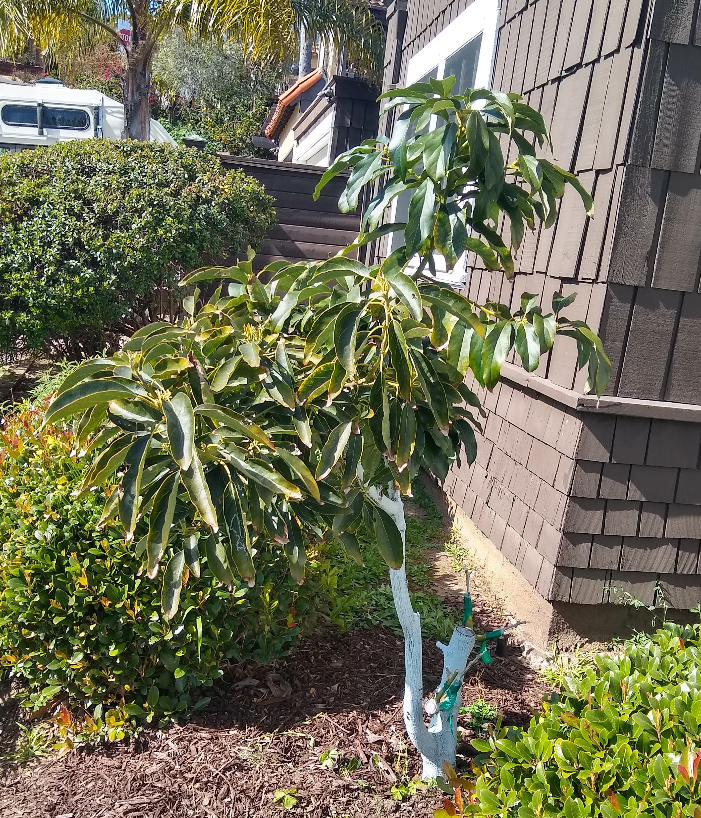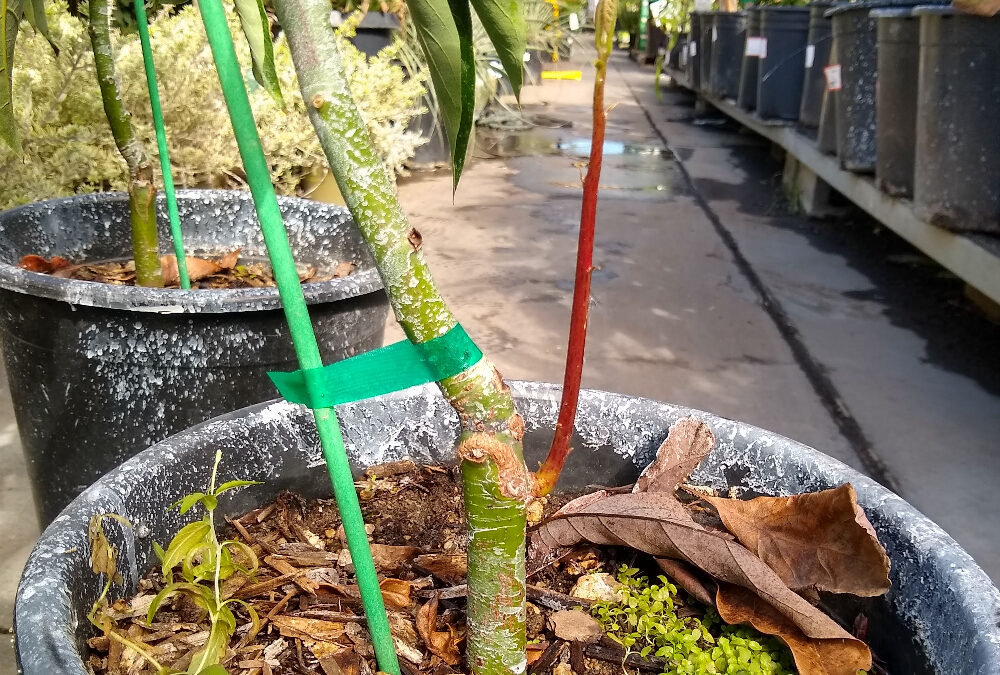If I owned a nursery, each time I sold a fruit tree I would attach a flyer that explained rootstock suckers. Too many innocent fruit trees get overtaken by their rootstock while the gardener doesn’t notice . . . until:
“Why are my oranges sour?”
“Why is my plum tree so thorny?”
And so it goes with avocados.
Not only do home gardeners sometimes lose their avocado trees to rootstock, but farmers can also get suckered:
Graft onto rootstock suckers?
How about grafting onto rootstock suckers rather than cutting them off? This is a great idea, especially if you have the grafting skills and the rootstock is large like the last one shown in the video. I recently did this to a tree in a friend’s yard:

Whether cutting off the rootstock sucker or grafting onto it, if branches are not shaded by leaves be sure to paint them to prevent sunburn.
All of my Yard Posts are listed HERE
I hope you find my Yard Posts helpful, and I appreciate your support so I can continue.




I had a rootstock sucker that I didn’t notice and it grew to over 12 feet before I realized it wasn’t the haas that I wanted. I tried my hand at grafting from a neighbor tree a few times but didn’t have any luck with it. Last year the haas branches put out its first and only fruit, I took it as a sign that I might be able to get more if I did things correctly so I cut off the huge rootstock sucker (now a tree in its own right) and with the heavy rains of the past winter the haas is growing like crazy. I still don’t know if I’ll be getting any flowers or fruit but things look promising. I’m guessing that the time spent growing that rootstock also grew a nice strong root system. I sure hope so, we’ve lived here 12 years and tried to grow avocados with 3 different trees and have thus far netted only that one fruit.
Fingers crossed.
Here is an idea what you can try to do, if you have a rootstock sucker that “escaped” and has basically been growing to the size of a tree in its own right:
You might be curious to find out what type of fruit this tree will produce, eventually, prior to removing it. ( Let me point out here that the chance to get decent fruit from such a sucker is rather low and in any case only exists if you have a tree on seedling rootstock, as was the case in the garden of Rudolph Hass*). Ok, so in case you have a tree grafted to a seedling rootstock (NOT a clonal rootstock) you could cincture the sucker at the base, which will speed up the formation of flowers on the cinctured tree. Once you have obtained first fruit, you can then decide what to do: cut the sucker off or keep it.
* as far as I know, Rudolph Hass was the luckiest person in this regard ( he just waiting for so long that his sucker started bearing fruit, which we all know as the ‘Hass’).
I love it, Stefan. Why did I forget that opportunity?
Maybe it was because my mind was on those specific GEM trees, which are on clonal Dusa rootstock. And as you alluded to, Dusa fruit is known so there’s nothing to discover, not to mention that it is not great to eat.
This makes me think about one downside of so many farms being planted to clonal rootstocks these days. It removes the potential for seedling rootstocks to “escape” and become discovered as new and excellent eating varieties, as was the case with Hass, as you mentioned, and Pinkerton and others.
Since nearly every tree I graft is part of our breeding efforts, I’ve become rather adept at keeping rootstock suckers and grafted trunks in balance, at least for young trees (haven’t been at this long enough to know if it’ll be just as easy later).
It’s funny how some grafts struggle to keep up with sucker growth rates, while other times it’s the rootstock branch that struggles. “Duke” grafts, for example, tend to grow more vigorously than anything they are grafted on other than its own seedlings.
For others trying this technique, the key is regularly pinching growing tips on the more vigorous trunk any time it starts being larger, and don’t hesitate to prune off any branches the more vigorous trunk has that shade the other trunk.
A timely post for me. I just found two suckers on my Bacon tree planted last year. I had not known to look out for them. They were going like rockets..
Hi Greg, thank you for sharing your experiences. I recently bought a couple avocados from a local nursery. I’m having trouble identifying the graft union on them in order to eliminate rootstock suckers. (The nursery pointed out a lower limb growing well on my hass, however after hours on your website I’m thinking it’s a sucker.
Anyway I can send you a couple photos?
Great video (and series!)- I just found you today! I was looking for trimming advice and saw your article https://gregalder.com/yardposts/pruning-avocado-trees/ which contained the link to this video/article: thank you for your expert advice! My question: is it possible for a new tree to grow from a seed that fell, right next to the main trunk? I was planning to cut back/down/way down my tree (now I know to wait till winter/early spring- ugh as I was planning to do it next weekend) and noticed what seems like a new tree itself coming straight up and out of the ground and NOT from the lower part of the trunk. We’re in South Florida. Can’t say what exact kind of avocado tree it is, bought it at Lowe’s maybe 15-20 years ago. I can’t say if that contributed to the many flowers and fruits this season as I just noticed it yesterday!